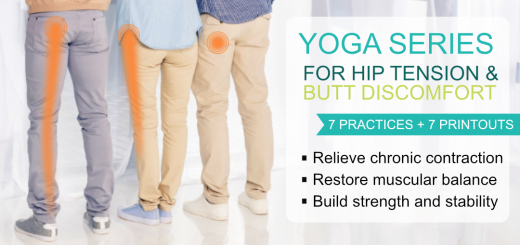Does sweating during your yoga practice help you detox?
23“I didn’t even break a sweat” – says my husband disapprovingly when his workout doesn’t meet his intensity expectations. We’ve come to associate sweating with working hard, and many folks also believe that it helps us to detox – release harmful toxins that accumulate in our bodies from living in a polluted world. As a result some yoga teachers have adopted the attitude of “sweat them good” as an intention for their yoga classes, both to give their students a sense of working hard and to help them “detox”. So they crank up the external temperature and the intensity of the workout (both generate heat). Today we will take a closer look at those claims.
There is no shortage of articles and books on the subject of detoxification and it immediately becomes clear that there are two conflicting opinions on the subject. But first let’s take a closer look at the process of sweating.
There are two types of sweat glands in your body: eccrine and apocrine. Eccrine glands are located all over the body, their job is to regulate body temperature. It goes like this: your body temperature goes up (because of exercising or high external temperature) – your brain triggers your eccrine glands to produce moisture that shows up on your skin’s surface – moisture evaporates, cooling you down. (That is why if the environment is humid, the sweat doesn’t evaporate as well, the body doesn’t cool down as well, and you have higher risk of overheating and dehydrating). Apocrine glands exist only in certain areas of the body (like armpits and navel), they produce sweat in response to stress or stimulation.
According to most MDs, all sweat consists mostly of water, some sodium and chloride, a bit of potassium and a very small amount (less then 1%) of toxins. Because of that most doctors will tell you definitively – no, sweating does not help you release toxins. Toxins are mostly released through urine and feces, once the liver, kidneys and intestinal tract are done processing them.
Then there are natural medicine advocates that proclaim that “New research is revealing something remarkable about why the body sweats. Beyond its obvious role in regulating body temperature, sweating has been found to facilitate the elimination of accumulated heavy metals and petrochemicals, indicating that if we want to be healthy we should put regular effort into doing more sweating.” Those claims seem to hinge mostly on the work of Canadian scientist, Stephen Genuis, PhD and his team. In his articles Dr Genuis [don’t you love that name?!] states: “Toxic elements were found to differing degrees in each of blood, urine, and sweat. […] Many toxic elements appeared to be preferentially excreted through sweat.” His studies, along with other smaller studies, seem to point toward the conclusion that “Sweating offers potential and deserves consideration, to assist with removal of toxic elements from the body.” (See the summary of the research)
All the studies mentioned here are small (between 2 and 30 people), include much speculation and possess many limitations.
“Although authors described thorough precleaning methods, sweat concentrations measured in research settings are not well validated and varied according to the location on the body, collection method, and from day to day according to other variables such as hydration. Sweat contains metals not only from the blood plasma, but also evidently originating from dermal layers (particularly with significant dermal exposures, as for workers in welding, smelting, or battery manufacturing). It would appear that large variabilities in measured concentrations, apart from collection methods as mentioned above, were likely the result of differences in excretion amongst widely varying individuals with ranges of body burdens, genetic polymorphisms affecting detoxification efficiency, and physiological states, coupled with necessarily crude if simple experimental techniques. These variations were very much greater than would be expected due to limitations of analytical methods.”
This basically means that the results were all over the map – sweat concentrations varied greatly from day to day and from one body part to another; sweat contained metals from the skin’s surface; both concentration and detoxification efficiency varied widely from individual to individual. And we also have to remember that the amount of toxins was very, very small.
After analyzing the studies the authors state that “Undoubtedly further research in this area would improve understanding, but the available evidence suggests that physicians could consider recommending sweating as tolerated via exercise (preferred) and/or use of a sauna as a low-risk, potentially beneficial treatment for individuals who may be experiencing effects of toxic elements, or for individuals with regular exposure to or accretion of toxicants.”
Where does it leave us? It is possible that the traditional medical approach underestimates the potential benefit of sweating, and it is just as likely that the natural health-oriented community overestimates it.
Sweat does contain trace amounts of toxins, says Dr. Dee Anna Glaser, a professor of dermatology at St. Louis University and founding member of the International Hyperhidrosis Society, a medical group dedicated to the study and treatment of heavy sweating.
Sweating definitely won’t help clear the body of mercury or other metals, says Donald Smith, a professor of environmental toxicology at UC Santa Cruz, who studies treatments for metal poisoning. Almost all toxic metals in the body are excreted through urine or feces, he says. And less than 1% are lost through sweat.
Roger Clemens, director of an analytical laboratory at the University of Southern California that evaluates environmental toxins in the food supply says that the most efficient system for detoxification is the kidneys, liver, gastrointestinal tract and immune system. “Except when one of the major organs breaks down, there isn’t a medical device or any diet that can accelerate the body’s natural process of detoxification,” he says. Or any type of exercise, for that matter.
It seems possible to release a small amount of toxins via sweat during an intense physical activity. But you do not have any control over whether or not it will happen to you, which toxins get released and how much. And we certainly cannot say that specific activities and/or poses can facilitate that process. So if a yoga program claims to help you release toxins, it basically means that it will make you sweat by making you very, very hot. Anything beyond that is an overreach.
So does breaking a sweat indicate a more complete yoga practice? It depends on what you are after. I like to differentiate between the internal and external intensity. External intensity means dialing up the actual physical challenge of the practice, which will make you sweat and might give you a sense of accomplishment. Internal intensity means staying present with what you are doing, moving with your breath and using your yoga practice to gain deeper understanding of who you are. In my book, internal intensity is more important then external intensity. I can be sweating buckets in a yoga class and feel completely untouched. Or I can be doing very little movement but come out of my practice feeling more focused, vital and strong. You can certainly combine the two, if it is appropriate for your health, activity level, physical conditioning, and so on. We just need to be clear about our goals – are we after strictly physical benefits or do we want the full experience of what yoga has to offer?
Now back to detoxification. If it takes place in the kidneys and liver, is it possible to promote detoxification by “massaging” those organs, increasing the blood flow via certain poses? We will continue this conversation next week!





















Very interesting and informative. In addition to more traditional yoga classes, I also teach a Hot Gentle class–fewer transitions, less advanced/intensive postures, slower pace, and emphasis on breathing and self-awareness. Would you comment on the use of heat in yoga classes? Thank you.
Hi Janis! I will be talking about it in more detail next week – who is heat appropriate for, and who gets dehydrated easily – lets save this conversation till next week!
Thank you for a balanced and well-researched article. I agree with you about internal intensity…I think that is a lovely way of describing the experience!
Thank you Elaine!
I like this blog, particularly your next-to-last paragraph. As I read it, I was reminded of dog training, Cesar Milan-style. He would often advocate mental exercise as much as physical exercising of the dogs. And I found that when my own dog had an injury and could not run as usual, I could tire him out by creating mental challenges for him. I think a yoga practice in which one is totally focused with what’s going on can be quite challenging and as you said may leave you feeling more focused, vital and strong.
Hi Barbara – I agree! I had a student tell me once that he mentally went through the practice we did the day before while he was waiting for a concert to start (utilizing the breath, of course), and had a very similar response that he had to the actual practice. Interesting how the mind works!
I adore your work, Olga! Your posts are so thoughtful and well-researched. I’m looking forward to engaging with them more as I return to school for ayurveda training this fall. Thankyou!
Thank you Ally! Ayurveda training sounds great! We will be talking a bit about it next week; would love your feedback!
Although I teach hot yoga I am very skeptical about the claims in terms of detoxification, so I found this article very interesting.
When I was in teacher training I was told that the sweat in hot yoga is good because it kills the bacteria on our skin. I am also a biologist and I found this statement to be utterly bewildering. Our skin and most of our whole body, is covered with and consists of beneficial microbes. If our sweat killed them, we would be in big trouble health wise. It is true that sweat and tears contain enzymes which can lyse certain bacteria. This is part of our first line of immune defence, however many have adapted to resist heat and a good sweat is not going to deport them all.
So thank you for this article. I think it’s so important that as yoga teachers if we are going to make broad health claims, that we are clear of the science and medicine behind them.
Hi Sarah – thank you for your comment! I haven’t heard the statement about sweat killing bacteria – indeed that would be very unfortunate! There is so much interesting misinformation circulating out there; I hope that as yoga teachers we can learn to be a bit more selective :).
The claim that sweat is a detoxification process in itself kinda bugs me amd I’m glad to read this.
Here’s my addition.
Toxin is the name given to waste materials in cell metabolism. These toxins are removed from cells by the blood stream and filtered out by the kidneys, and breathed out by the lungs, as carbon dioxide is one of the waste material of cell metabolism.
So, if you exercise, you’ll increase the effort placed on cells, meaning they metabolise more energy, meaning they will create more toxins. This increase in energy production will heat the body, which for most people will mean they sweat as the body tries to cool itself. Meanwhile the cells are happily churning energy and excreting toxins into the blood stream. Which then gets filtered and breathed out.
Now, ive skipped a tonne of stuff, but like all physiological process, its more complex than an article title, and people want the sound bite to be the whole story.
Thank you for your addition Dave! I completely agree – the body is very complex and we only scratch the surface with articles like that 🙂 Thank you for bringing up this additional issue – I think some of us have different understanding of the term “toxins”. My article mostly talks about “toxins” as heavy metals and other stuff that we collect from the environment, rather then the waste product of cell metabolism. The studies that I mentioned talk about arsenic, cadmium, lead, and mercury, and the pathways through which they leave (or not leave) the body. And I am sure that people who talk about “detoxification” use the term “toxins” to mean one or the other (or both)!
yup, don’t you love the ambiguity of these types of terms.
I was going to provide some references for mine, but my library is deficient (or my hunting skills are today) so i can’t even back my statement up with some literature… :/
regardless, good article, hats off
🙂 Let me know if you come across something interesting on the topic; it sure can be a touchy subject in the yoga community 🙂
Hello Olga,
I’m so happy to have found your blog. It’s full of great information and very well balanced. Thank you for your efforts.
Thank you Maya!
Thanks for this article Olga… particularly appreciated your summation regarding the internal intensity of intention and being present and going deep. This is hard work sometimes, much harder than breaking out in a sweat because of strenuous physical exercise… but ultimately that’s where I find my ‘workout’ most rewarding. Looking forward to the next instalment!
Thank you Cherise! For sure, the inner work is often much harder then breaking a sweat and I feel the same way – it is the most rewarding.
Amazing article! I love how you use science and write so clearly that anyone can understand! Olga, thank you!
Thank you for this article! I’ve wondered about this for years but had a hard time finding reliable information. You did all the research for me!
Hari Om Olgaji
This topic invariably stirs up the hornet’s nest and spills all over.
But your enlightened write up and supporting inputs from others on this forum, has credibly ensured there is no spilling over.
Hope fully you will also touch upon another very sensitive topic. ‘ The role of heart rate ( or maximum heart rate? ) as related to Yoga practice’.
Yogicly
Abhinandan
I thought twists helped release toxins in your body. Maybe your next article will address this?
Hi Linda! I wrote about detoxing here: http://sequencewiz.org/2015/07/15/can-twists-detox-the-liver/